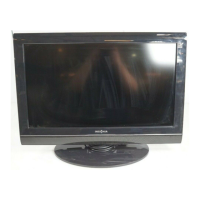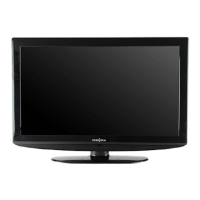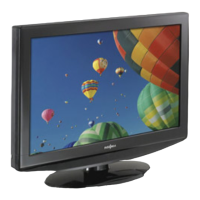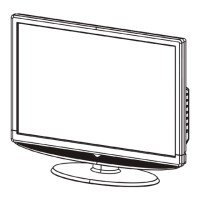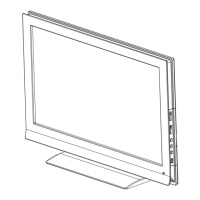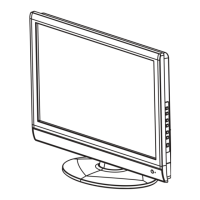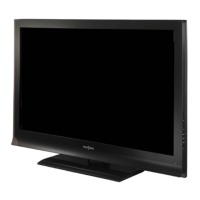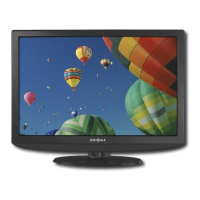How to fix an Insignia NS-L22X-10A LCD TV when the LED does not blink when pressing a key?
- JJuan JacksonJul 31, 2025
Try pressing different keys or replace the batteries with two new AA batteries.
How to fix an Insignia NS-L22X-10A LCD TV when the LED does not blink when pressing a key?
Try pressing different keys or replace the batteries with two new AA batteries.
Why is there no volume on my Insignia LCD TV?
If there's no volume, check “Changing volume lock” on page 35 to ensure the volume isn't locked to a different mode.
What to do if my Insignia NS-L22X-10A remote control does not control devices?
If your remote isn't controlling devices or commands aren't working, try all the listed codes for the device. Also, verify that the device is compatible with an infrared remote control.
What to do if the LED blinks when I press a key, but my Insignia NS-L22X-10A does not respond?
Make sure the remote control is aimed at your device and is within 40 feet.
What does it mean if the LED blinks one long blink while in SET mode on my Insignia NS-L22X-10A LCD TV?
A long blink in SET mode indicates an entry error, such as an incorrect key. Try entering the sequence again.
Provides essential safety tips for enjoying your new flat panel display and preventing injury.
Offers guidance and warnings for safely mounting your TV to a wall, emphasizing proper hardware and professional installation.
Covers essential warnings related to electric shock, lightning, power lines, and handling the LCD panel.
Provides specific instructions and precautions for handling the glass LCD panel to avoid breakage and injury.
Details important safety checks for service personnel and precautions for replacement parts.
Outlines conditions under which the TV should be serviced by qualified personnel to avoid further damage.
Explains the importance of proper grounding for outdoor antennas to protect against voltage surges and static charges.
Provides guidance for CATV system installers regarding correct grounding procedures according to electrical codes.
Warns about condensation issues from temperature changes and interference from mobile telephones.
Advises on the proper disposal of materials like solder and fluorescent lamps, and recycling information.
Explains the presence of non-active pixels as normal and not a defect, affecting only a few pixels.
Step-by-step instructions for removing the stand and attaching a wall-mount bracket to the TV.
Lists the essential accessories included with the TV, such as remote control, cables, and cleaning cloth.
Provides instructions for using the cleaning cloth specifically for the TV screen, not other parts.
Guides on connecting the TV to a power source and various antenna types (outdoor, cable TV).
Details how to connect cable TV (with/without box) and VCRs to the TV using AV or coaxial cables.
Explains how to connect camcorders, game consoles, and HDMI devices to the TV's AV and HDMI ports.
Provides instructions for connecting devices using component video and S-Video cables for higher quality video.
Guides on connecting computers via VGA/HDMI and connecting digital or analog audio amplifiers.
Specific instructions for connecting an analog audio amplifier using standard audio cables.
Guides the user through the initial setup process, including language, source, and channel list configuration.
Explains how to turn the TV on and off, including standby mode and power cord disconnection.
Details how to switch between different connected devices using the INPUT button or remote control.
Explains how to use the remote control buttons (MENU, navigation, SELECT, EXIT) to interact with on-screen menus.
Describes methods for selecting channels using channel up/down, number buttons, and the RECALL function.
Explains how to press INFO to display TV status like channel number, signal strength, and program descriptions.
Guides on adjusting core picture settings like Mode, Brightness, Contrast, Color, Tint, and Sharpness.
Details advanced picture adjustments including aspect ratio, overscan, color temperature, and noise reduction.
Covers adjustments for Audyssey Dynamic Volume, SRS TruSurround HD, Treble, Bass, Balance, and audio language.
Explains how to turn off the TV picture to listen to audio only, typically used for radio or specific content.
Guides on scanning for available channels and storing them in the channel list for easy tuning.
Explains how to hide specific channels from the channel list, allowing them to be skipped during tuning.
Details how to create and manage a list of favorite channels for quick access and personalized tuning.
Instructs how to access and tune to channels previously added to the favorite channel list.
Guides on assigning custom labels to channels for easier identification and management.
Guides on setting up a parental control password to restrict access to content based on ratings.
Explains how to set content ratings (MPAA, TV Parental Guidelines) to block programs for children.
Details how to block TV programs that do not have rating information, ensuring content suitability.
Provides instructions on how to download rating information for DTV channels to enable parental controls.
Explains how to turn closed captions on or off using the CCD button for accessibility.
Guides on selecting different closed captioning modes like CC Off, CC On, or CC On When Mute.
Details how to customize the appearance of digital closed captions, including font, color, and size.
Provides instructions for setting the TV's internal clock, including date, time zone, and daylight savings.
Guides on setting the sleep timer to automatically turn off the TV after a specified period.
Explains how to select the desired language for the TV's on-screen menus.
Guides on adjusting the transparency level of the on-screen menus for better visibility.
Details how to assign custom names to input sources for easier identification of connected devices.
Explains how to adjust the brightness of the INSIGNIA logo displayed on the front of the TV.
Guides on enabling or disabling Auto Input Sensing to automatically select active video inputs.
Provides methods for finding compatible codes for universal remote control programming.
Explains how to use the remote's learning feature to copy functions from original remotes.
Guides on creating macros to perform sequential key presses with a single button press.
Offers solutions for common problems encountered during remote control setup and operation.
Lists remote control codes for various audio amplifiers and receivers from different manufacturers.
Provides remote control codes for video accessories, cable converters, and CD players.
Lists remote control codes for DVD, Blu-ray, and HD-DVD players from numerous brands.
Contains remote control codes for TVs, TV/VCR, TV/DVD, and other combination devices.
Provides instructions for cleaning the TV's exterior cabinet using a soft, lint-free cloth.
Guides on safely cleaning the TV screen using a specific cleaning cloth or soft, lint-free cloth.
Offers solutions for the TV not turning on, including checking power connections and cord.
Addresses common picture issues like no picture, poor picture, and unstable images, providing resolution steps.
Provides solutions for problems with sound, such as no sound or poor audio quality, and checking settings.
Offers troubleshooting steps for remote control problems, including non-responsiveness and battery issues.
Details compliance with FCC Part 15 rules for digital devices and radio frequency energy.
States compliance with Canadian Class B digital apparatus standards (ICES-003).
References Dolby Laboratories license and HDMI Licensing LLC trademarks for multimedia technology.
| Screen Size | 22 inches |
|---|---|
| Resolution | 1366 x 768 |
| Backlight Type | LED |
| USB Ports | 1 |
| Aspect Ratio | 16:9 |
| Refresh Rate | 60Hz |
| Audio Output | RCA |
| Inputs | HDMI, USB, RF, Composite |
| Sound Output | 5W x 2 |
